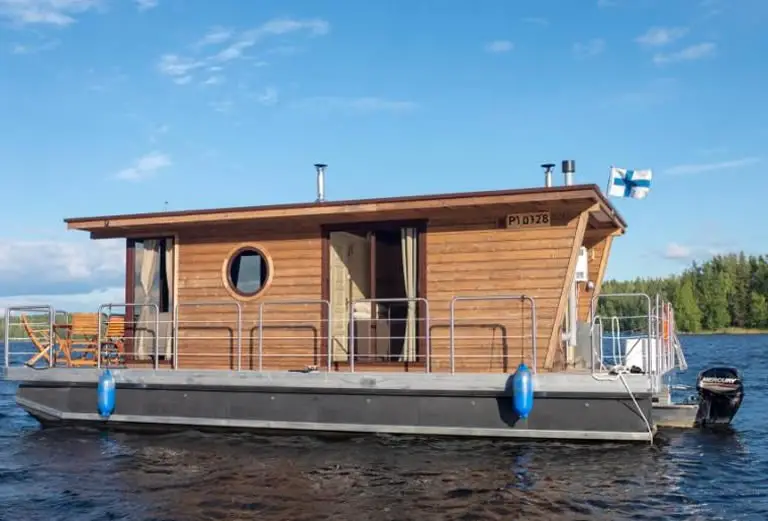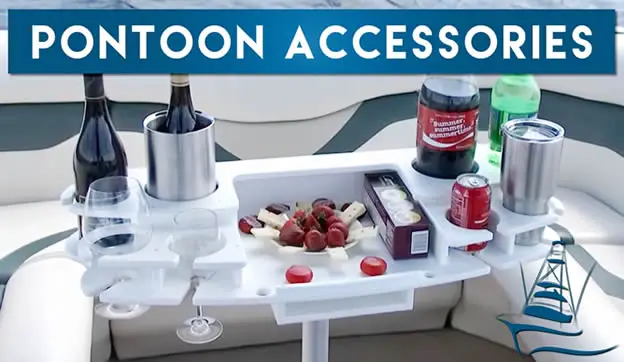In this article I cover the essential things you need to know about the humble houseboat. I outline exactly what a houseboat is, its basic design and construction and also answer the most frequently asked questions about these unique vessels.
Contents
- What a houseboat is and why it’s often called a pontoon houseboat
- You can live permanently on a houseboat year-round
- The best places to use houseboats
- Houseboat construction – what traditional and modern houseboats are made of
- Ending the confusion between a houseboat and a yacht
- Is a houseboat a legal vessel?
- A houseboat is often used as a dwelling place but legally-speaking it is just a boat
- When traveling with a houseboat is possible & when it isn’t
- The average speed that houseboats can travel
- The type of distance you can travel in a houseboat & the associated cost
What a houseboat is and why it’s often called a pontoon houseboat
When you think of a pontoon boat you may immediately think of a pontoon boat party but not all pontoon boats are good for that purpose. A houseboat is a unique type of water vessel that is popular in many countries throughout the world.
A houseboat is flat bottom vessel that has one or more cabins on its deck space. It may, or may not, have additional buoyancy support from pontoon tubes under the hull. It usually has platforms at one or both ends of the boat.
Houseboats are used primarily as permanent living quarters for one or more persons but are also used for vacations. Houseboats in America and Africa are usually kept buoyant by 2 or 3 pontoons, while houseboats in other countries are usually completely flat bottomed.
Thus you may hear people referring to this type of boat as a pontoon houseboat or merely as a houseboat, depending on where you are in the world.
A US houseboat can be loosely thought of as an American equivalent to a British/European narrowboat as many people in Europe live on canals in narrowboats. But unlike narrowboats, which are almost exclusively used in narrow canals, houseboats can be found in many different types of waterways from rivers and streams to lakes and coastal bays.
In the US houseboats are most often found in inland waters on rivers and streams and in lakes, where there are calm waters. They are very easy to drive and maneuver. The most difficult aspect of driving a houseboat is docking it.
As a flat bottom vessel, a houseboat in North America is usually kept buoyant by the use of pontoon tubes, so in many respects we can view a houseboat as a very unique type of pontoon boat though its function is very different. Where pontoon boats are recreational vessels built for comfort and water-based fun activities, a houseboat has a much more practical purpose.
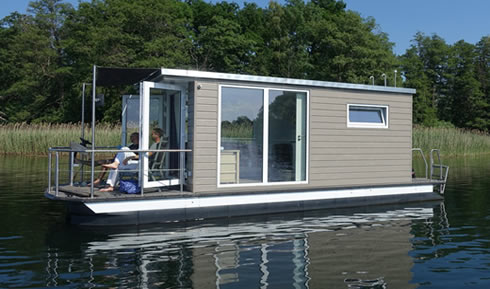
In other areas of the world, such as India and most parts of Europe, houseboats do not use pontoon tubes and are completely flat bottomed. These type of houseboats can only be used in shallow calm water and are therefore most often found in canals and calm rivers. In most countries no special licence is required to operate a houseboat.
Most states in the US you do not require a special license to operate a houseboat though California requires everyone to take a course. Florida requires anyone born after 1988 to take a boating course and Texas has also mandated that anyone born after September 1993 must complete a course to operate a houseboat.
You can live permanently on a houseboat year-round
Although modern houseboats are becoming popular as summer homes and for short vacations this does not mean that they are limited to only warm weather use. So does this mean you can live on a houseboat all year-round?
It is possible to live on a houseboat year-round. Many houseboats are designed as permanent residences and many have modern appliances, such as climate control. Thus making living in a houseboat possible in all seasons.
Additionally, as houseboats can be moved it is possible to relocate the vessel to a more secluded and secure area if the weather becomes very challenging.
Although many houseboat owners keep their boats stationary year-round (as many have permanent jobs and locality-specific responsibilities) a houseboat that is permanently maintained in an area where the water freezes may need to be moved to a different location when the temperature drops below freezing.
Alternatively many houseboat owners will use a bubbler system or a dock de-icer to break up the ice around the boat to protect the boat from ice damage. Both these approaches are very effective ways of dealing with compacted ice that could damage the boat’s hull or pontoon tubes.
People who live in places that get freezing winters will also winterize their boat’s motor as well as its internal plumbing system. This do this by simply adding the appropriate antifreeze to fuel system and the plumbing system. This not only protects the motor from freezing but it also removes the risk of busted pipes inside the boat. Obviously antifreeze cannot be added to the freshwater supply but other precautions can be put in place such as heating devices or by simply using portable water coolers.
As a houseboat is usually kept in fairly shallow inland water areas rough weather is not so much of a consideration for the houseboat owner. Even in high winds and nasty winter weather a houseboat will remain a safe haven, though it may be a bit rocky. Lake based houseboats may need to be docked in naturally, or artificially, shelter areas close to the littoral zone.
Obviously the summer months are less of a consideration when it comes to boat safety, though for comfort in areas that experience high summer temperatures some form of inside air conditioning is advisable.
The best places to use houseboats
Where would you commonly see a houseboat?
Houseboats are mostly used in calm inland waterways such as rivers, streams and lakes or in sheltered harbors in coastal regions. They can be found in many countries around the world from India and Africa to Europe and America.
In India traditional houseboats are used for both local accommodation and for tourists. There are a number of places in India where houseboats are a common site on the rivers.
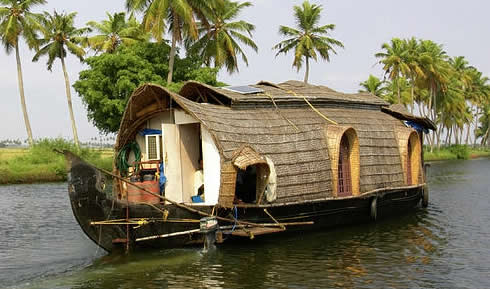
Africa has a large tourist industry that utilizes houseboats for river tours and these boats are usually modern watercraft that sit on pontoon tubes though completely flat bottom watercraft are also prevalent.
In Europe the most common type of houseboat is the narrowboat which is especially popular in the UK and Ireland.
Although there is a large community of people who live permanently aboard narrowboats the vast majority of people who take to the water on a narrowboat do so for vacation purposes only. There are narrowboat vacations available in the British Isles as well as across many parts of Europe.
Houseboats in America come in all shapes and sizes though they are much more likely to use pontoon tubes than those found in other countries. Although the basic premise of the boat remains the same the addition of pontoon tubes, for extra buoyancy, allows most American houseboats the capacity for traversing rougher water than their international cousins.
Houseboat construction – what traditional and modern houseboats are made of
So what is a houseboat made out of?
Traditional houseboats are made of wood and those found in India and other parts of Asia are still made this way. Modern houseboats in Africa, Europe and America can be made of a mixture of wood, steel, aluminum and fiberglass.
Houseboats that utilize pontoon tubes for buoyancy will usually use PVC or aluminum pontoons regardless of the hull material.
In India traditional houseboats are usually constructed of wood and are flat bottom scows with cabins on deck (see image above). They are used for homes and also for transportation as well as accommodation for tourists.
In Europe, America and Africa most houseboats are constructed of a mixture of more modern materials and are kept as lightweight as possible. This is advantageous for those houseboats that sit directly on their flat bottom hull rather than using pontoon tubes.
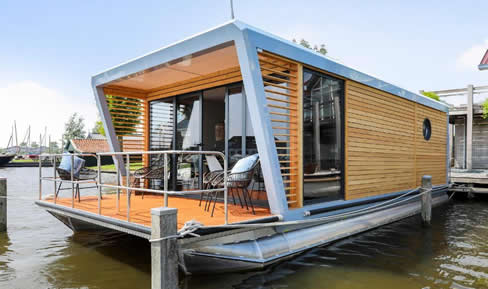
Although some materials will be more durable and more damage-resistant than other materials, the main consideration when it comes to the construction material of a houseboat will be rot. For example, an aluminum hull is not a good idea for a houseboat that is used in saltwater due to galvanic corrosion. Even houseboats that are made of other materials, such as steel or fiberglass, could be at risk in saltwater if they sit on aluminum pontoon tubes – something I pointed out in the article do pontoon boats need anodes.
Ending the confusion between a houseboat and a yacht
Many people wonder if a houseboat is the same as a yacht because it is possible to live on both types of boat. Is a houseboat a yacht?
A houseboat is not a yacht. While yachts can be used in the ocean, houseboats are not designed for ocean use. On the flip side most yachts have deep drafts that make them unsuitable for shallow water use, while the shallow draft of a houseboat makes it perfect for rivers, streams, lakes and other shallow inland waterways.
Although it is possible to live on a yacht, just as you can live on a houseboat, the two vessels are completely different in design and function. Yachts are designed for good stability in deep waters and can be used in ocean waters. They can not be used in very shallow waters.
Houseboats on the other hand are designed for superior stability in shallow waters and cannot be used in turbulent open waters like the ocean. They are perfect for shallow waterways however. Most houseboats can navigate waters that are only a few feet deep and some can be used in exceptionally shallow waters of just a 12″. This makes houseboats an excellent vessel for calm inland waterways and lakes.
Is a houseboat a legal vessel?
Legally speaking is a houseboat considered a vessel?
A houseboat is considered a vessel under maritime law. This means that legally, if you own a houseboat, you own a vessel and are subject to all the legal requirements that owning a vessel entails.
A US Supreme Court ruling concluded that a houseboat is a vessel in a case that was brought against a houseboat owner by a city-owned marina in regards to dock fees.
The houseboat owner, Fane Lozman, contended that his houseboat was a permanent home and not a vessel and was therefore not liable to vessel fees, while the city-owned marina contended that is was a docked vessel and therefore subject to marina and associated vessel fees.
In the 2013 case the Supreme Court ruled that Lozman’s houseboat was indeed a vessel even though it had no means of propulsion or even a steering mechanism.
You can read more about the case here.
A houseboat is often used as a dwelling place but legally-speaking it is just a boat
From a legal viewpoint is a houseboat considered a dwelling?
A houseboat is not considered a dwelling according to maritime law. Due to the 2013 US Supreme Court ruling that a houseboat is a vessel it therefore cannot be considered a dwelling. For HMDA purposes there is an exclusion for houseboats and floating homes built prior to June 15, 1976 as well.
As stated on Wikipedia a dwelling is:
In law, a dwelling (also residence, abode) is a self-contained unit of accommodation used by one or more households as a home – such as a house, apartment, mobile home, houseboat, vehicle, or other “substantial” structure. The concept of a dwelling has significance in relation to search and seizure, conveyancing of real property, burglary, trespass, and land-use planning.
However, due to the ruling of the Supreme Court in 2013 against Fran Lozman, and also the subsequent HMDA exclusions, a houseboat is now considered a vessel under maritime law and not a dwelling (if it was built prior to 1976).
The HMDA exclusion for houseboats is as follows:
” Exclusions. Recreational vehicles, including boats, campers, travel trailers, and park model recreational vehicles, are not considered dwellings for purposes of § 1003.2(f), regardless of whether they are used as residences. Houseboats, floating homes, and mobile homes constructed before June 15, 1976, are also excluded, regardless of whether they are used as residences. Also excluded are transitory residences such as hotels, hospitals, college dormitories, and recreational vehicle parks, and structures originally designed as dwellings but used exclusively for commercial purposes, such as homes converted to daycare facilities or professional offices.”
If you intend to live on a houseboat, or just vacation on one, then you may want some of these amazing pontoon boat accessories to make you time onboard better and more fun.
When traveling with a houseboat is possible & when it isn’t
Can you move a houseboat or are they permanently docked and stationary?
Houseboats that are fitted with a propulsion system, such as a motor, and that have a working steering mechanism can travel. Many houseboat owners will move their vessels throughout the year. However, some houseboats are permanently docked with no form of propulsion or steering mechanisms and therefore can not travel.
Most houseboats can travel. Houseboats are designed first and foremost as boats. Therefore they are made to move on the water. Only vessels that have been deliberately modified to remove the motor and/or steering mechanism, or that are damaged, cannot travel.
The average speed that houseboats can travel
Can you enjoy fast speeds across the water in a houseboat like you can in a pontoon boat … how fast can houseboats travel?
The average houseboat will travel at a speed of 4 mph (3.5 knots) but can reach speeds of about 8 mph (7 knots) depending on conditions. Houseboats are not fast vessels.
The design of a houseboat and the amount of weight that the vessel tends to carry (being essential a floating house) means it is slow compared to other vessels. Even houseboats that rely on pontoons for buoyancy and stability will never travel as fast as a regular pontoon boat.
Even if you could travel fast in a houseboat you would not want to as increased speed would likely cause the boat to nose dive due to its design.
The type of distance you can travel in a houseboat & the associated cost
So we now know that houseboats can travel albeit as a very slow pace, but how far can they travel?
Many sites cite that a houseboat will use on average 1 gallon of fuel per 1 mile or even per 1/2 a mile. However, this is not at all accurate.
An average size houseboat with a single engine will use 1 gallon of fuel every 3 – 4 miles. So, with a tank capacity of 50 gallons an average houseboat can travel between 150 – 200 miles on a full tank of fuel. With a tank capacity of 200 gallons an average houseboat can travel between 600 – 800 miles.
As you can see traveling in a houseboat isn’t exactly cost-efficient when you consider that modern road transportation costs much less.
An average road vehicle in the US will cover about 25 miles for every gallon of fuel it burns i.e. 25 mpg – you can get as much as 57 mpg from cars in Europe but that’s a discussion for another day. When you compare the low mpg you get from a road vehicle to 3-4 miles per gallon you get from a houseboat you can clearly see that it is much more expensive to travel by water. However, you do get to take your entire house with you!

